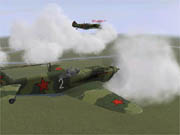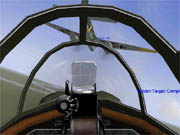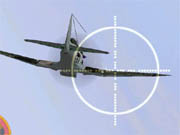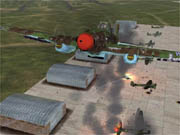IL-2 Sturmovik is destined to be a classic. This is one of those simulations that reminds you why you love the genre. It has all the fidelity, immersion, playability, polish, and graphical splendor that enriched classics like Red Baron, Aces over the Pacific, Falcon 3.0, and European Air War. This is why we fly.

IL-2 is arguably the most beautiful flight sim to date. The volumetric clouds, the atmospheric lighting, and the weather effects are the stuff of tech demos. What a delight to see them in a fully realized game. Instead of using generic urban texture tiles, towns are modeled using hand-placed 3D objects (although they'll only appear at short range to keep the frame rate manageable). To create forests, IL-2 uses a clever trick with layered bitmaps that give the illusion of depth and multiple trees--it's a bold new effect that pays off much better than mere forest textures with fake shadows along one edge. Water has a rippled translucent look, and surf even laps at the shore. The aircraft models are superbly detailed, from chipped paint to moving control surfaces, down to every flap and leading edge slat. Your pilot's head even turns to look at his target. This is the sort of sim in which you can enjoy just watching the landing gear extend and retract.
When the shooting starts, the graphics really take off. IL-2 has a realistic tracer effect with occasional illuminated rounds for machine guns. Larger-caliber cannons and rockets leave sharp smoke trails, while dogfights at higher altitudes leave lazy twisting coils of contrails. Good-looking explosions and fire are a dime a dozen in games these days, and IL-2 is no exception. With variable zoom levels available, you can effectively stick your head up to the sights and fire at your target as if you were shooting footage with a gun camera. You can record your missions to watch them after the fact or to assemble them as cinematic replays from different perspectives. With graphics as sharp as IL-2's, this latter feature is a deceptively addictive time sink.
IL-2 sounds as good as it looks. It features distinctive engine sounds, hearty gunfire, thudding flak, and the Doppler zoom of a plane roaring past your canopy. The cockpit chatter is convincing and heartfelt, partly because it's all spoken in German or Russian. You may not like having to look up at the top of your screen to read the subtitles, but you'll eventually learn to distinguish mission-specific information from flavor messages. You can even tune to the enemy frequency to hear your victims' mayday calls. IL-2 also features some wonderfully subtle touches, like the sound of bullets whistling by or ricocheting off your fuselage. The metallic creaking and thrumming of these planes in motion is even more impressive. You can hear an impending stall as your plane's frame goes from creaking to rattling. This important aural cue is far more intuitive than any gauge or readout, and it works wonders for conveying the feel of flight in World War II-era aircraft.
Flight sim fans are notoriously fussy about realism, but IL-2 should give them little cause to complain. It also scales down for beginners and more casual players. A realism panel will let you toggle individual settings for the flight model, external views, situational awareness cheats, weapon lethality, ammo loadouts, and so forth. This isn't an arcade game by any stretch of the imagination, but if you just want to zoom around and blow things up with impunity, IL-2 will be more than happy to accommodate you. If you who want to faithfully re-create the nuances of World War II air combat, IL-2 will accommodate you. In fact, IL-2 seems downright eager in this regard.
The flight models are superlative, giving each plane a distinctive personality. From Russia's lumbering IL-2 bombers to Germany's nimble Bf-109s, each plane has its own style and character. None of the planes' responses feel canned or scripted. IL-2 is one of those rare games where you can almost feel the physics under your fingertips. This is especially important when you're modeling aircraft from a time before computers kept pilots from stalling or spinning their planes. It was up to the pilot to push the envelope of his plane's performance, sensing how close he was to the wrong side of the laws of physics. This sense for keeping a vehicle on the edge of control is one of the hardest things to model in a computer game. IL-2 is probably the best attempt at doing this since Papyrus' Grand Prix Legends.

The damage model is another unapologetically realistic aspect of IL-2. You can sustain a variety of different types of damage, none of which feels canned. You might even be surprised at touches like cowlings that have been ripped back from your nose obstructing your view through the canopy. The damage model for your own weapons is also unflinchingly realistic. Strafe a column of tanks with your machine guns, and they'll just carry on as if you were flinging spitballs--armored vehicles need to be attacked with cannons, rockets, or bombs. IL-2 doesn't just use a model of cumulative damage chipping away at a vehicle's hit points. Armor penetration and hit location figure prominently. Unload your machine guns into the rear of a bomber and you're liable to just chew up his tail while he goes about his business of dropping bombs on your airfield. It can be difficult to bring down a plane with smaller-caliber fire when you're shooting it from behind. To get the most out of your ammo, you'll want to aim at engines on wings or risk high-deflection nose shots in an attempt to hit a fighter's engine. When you finally shoot something down, it feels like real accomplishment. Of course, if this level of realism is frustrating, you can turn it off with the flip of a toggle.
The realism tweaks also extend to issues of what it's like to be strapped into a restrictive cockpit with no way to see behind you. You can choose to switch off external, padlock, and full-screen views, as well as the text labels that designate every aircraft by distance and nationality. Without these visual aids, IL-2 is at its immersive best. You're constantly unsure of what's behind you. If you chase a plane into a cloud, you won't know what the situation will be when you come out on the other side. Following a twisting, turning, weaving opponent is a gratifying challenge of the highest order. But if this isn't your bag, there's a great full frontal view with bright gauge overlays that makes IL-2 almost as accessible as Microsoft's Crimson Skies. One disappointing lack of realism in IL-2 is the developers' choice not to include swastikas on the German planes. While the sentiment is understandable, this sort of reluctance to model history only calls attention to itself and ends up being counterproductive.
A potential obstacle for IL-2's commercial success (as if being a flight sim not called "Microsoft Flight Simulator" weren't enough of an obstacle) is that it's set in a lesser-known corner of World War II. IL-2 takes place during the battle between Germany and the Soviet Union. You don't hear a lot about the air war over the eastern front, particularly since so much blood was spilled in the mud and snow. Since Germany decimated the Soviet air force, it wasn't much of an air war until the Soviets were driving them back to Berlin. This wasn't the dramatic back-and-forth struggle like Spitfires and Messerschmitts over the English Channel, P-51s and B-17s by the hundreds over Europe, or the pitched carrier battles in the South Pacific. Also, this air war isn't as "sexy" to the US market since there are no Americans involved (although there is a guest appearance by American P-39s sent to Russia under FDR's Lend-Lease Program).

But this is all the more reason to applaud Maddox Software for taking a chance by offering something new and different. Forgotten chapters of history like this are rich untapped territory. Even experienced flight sim fans will find they're not in Kansas anymore. There are some familiar German planes, namely the aforementioned Bf-109 and the fearsome Focke-Wulf FW-190. But the Soviet aircraft are like a cast of new characters. You'll meet MiGs, Yaks, and LaGGs in addition to the workhorse IL-2 bombers, each with its own charm and personality. Although the manual boasts 31 flyable aircraft, most of these are variants of about a dozen different aircraft.
The game's successful emphasis on ground-attack missions is another of its notable features. This isn't just a dogfighting sim. Although IL-2 doesn't support target-rich environments along the lines of Falcon 4.0, it gives you enough variety and detail that the ground-attack missions don't feel like a B-side feature. In addition to blowing up the usual suspects (airfields, armored columns, and bridges), there are moving trains and even torpedo runs on ships. You can tinker with the convergence distance for your weapons to tweak your strafing or configure delays on bombs and rockets for low-altitude, close-in attacks. IL-2 even supports skip bombing, a maneuver that actually skips ordnance across the top of the water into the side of its target. One helpful aid for ground attacks is the option to run the game at half- or quarter-speed. This lets you line up your targets carefully and, more importantly, makes it easier to figure out when you need to pull up from a steep dive.
One of IL-2's disappointing oversights mirrors one of Hitler's oversights: there's a notable absence of German bombers. Just as the Luftwaffe was short on bomber aircraft, the only flyable German planes in IL-2 are fighters. It's a mystery why Maddox didn't include the notorious Ju-87 Stuka, the most renowned ground-attack craft on the eastern front. As it is, if you want to focus on ground-attack missions, you'll be flying for the Russian motherland.
Although IL-2 is a superlative simulator, it's sitting in a rather bland case. The shell screens are a series of pushbutton panels with minimal information and a jaunty little Hogan's Heroes war tune in the background. The mission briefings give only scant information about what you're supposed to do. Even worse are the mission debriefings, which only show your accumulated score and kills for the entire campaign. There is no information about how the planes on your side performed, what planes you shot down, how accurate your gunnery skills are, or whether you were damaged. Given this, it's hardly surprising that IL-2 ships with a wretched manual. Curious about how the planes stack up against each other? Wondering what those dials in the cockpit mean? Want to get some insight into the campaigns and career mode? Would you like to learn how to use those controls for elevator trim, prop pitch, and armor flaps? Don't bother consulting the manual, because none of this is in there. There is a series of ponderous tutorials that run about 10 minutes too long and leave plenty of unanswered questions. So much for being accessible to new players.

Then there are the single-player campaigns, which are the worst offenders when it comes to not giving this sim what it deserves. There are three campaigns, each consisting of canned missions with sometimes demanding and unclear objectives that have to be met before you can move on. Unfortunately, you may not know whether you've met your objective until after you end the mission, at which point there's zero feedback on why you did or didn't succeed. Many of these missions will have to be replayed multiple times before you beat them. This sort of annoying structure has destroyed other sims, but IL-2 has enough flexibility to make up for it. For starters, there are 20 single missions to let you flex some of the different aircraft. Then there's a quick mission builder that lets you dial in preferences for anything from one-on-one tests to ground-attack practice to massive dogfights. There's also a beefy and easy-to-use full mission builder, in which you can load any of the campaign missions and fly them instead of having to slog through them in order. Finally, there's full multiplayer support for dogfights and cooperative play in specially created missions.
But best of all, there's a fan base that's already fleshing out this sim. For starters, you can download IL2Gen, Vadim Kolosov's handy random campaign generator. This little utility single-handedly rescues IL-2 from its restrictive campaigns. To get a sense for how far IL-2 might go, consider what's been done with Microprose's European Air War or Falcon 4.0, games that have been so heavily modified since their release that they're nearly unrecognizable. IL-2 looks like it'll inspire just as much third-party development from its devoted and industrious fan base. Try to tell these people flight sims are dead. They may be rare, but this is a genre that isn't going to go away anytime soon. With titles like Rowan's Battle of Britain, Razorworks' Comanche vs. Hokum, and now Maddox's IL-2, flight sims are reaching incredible new levels. And the good ones are more precious--in both senses of the word--than ever.